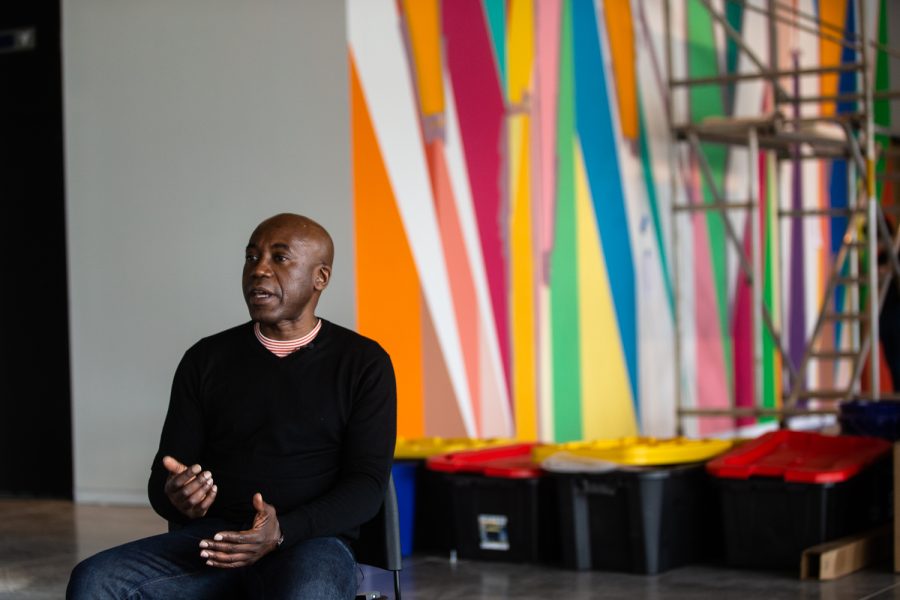A first look inside the new UI Stanley Museum of Art building
The Stanley Museum of Art’s new building features sleek architecture and multiple galleries and classroom spaces. The museum is set to open August 26.
Artist Odili Donald Odita responds to questions from the media at the Stanley Museum of Art at the University of Iowa on Tuesday, April 12, 2022. The Stanley Museum of Art is slated to open to the public on August 26, 2022.
April 12, 2022
The smell of fresh paint still fills the new Stanley Museum of Art, which is set to open in August 26.
From the polished concrete floors, black steel bordered windows that stretch from floor to ceiling, and a strikingly vivid, and a multicolor abstract mural that can be seen from down the block on Madison Street, the museum’s lobby is just an introduction to the University of Iowa’s new artistic paragon.
Years of planning, design, and reconstruction of the new Stanley Museum have nearly completed over a decade since the destruction of the original Stanley Museum of Art in the 2008 flood.
RELATED: Stanley Museum of Art set to open next fall with inaugural collection
Construction of the museum was mostly completed in December 2021. While the original opening date had been set for Sept. 2, 2022, it was moved up for a week’s worth of “Homecoming” celebrations following the initial ribbon-cutting ceremony.
Stanley Museum staff are currently preparing for the process of moving a portion of the UI’s extensive art collection into the space, including its famous 1943 Jackson Pollock painting, Mural.
The abstract mural located in the lobby of the museum, designed by Philadelphia artist Odili Donald Odita, is meant to reflect the Pollock piece. It will be a temporary installation, and the first in a series of lobby artworks called “Thresholds.”
Odita, who often uses vibrant but specific colors in his work, said that for many years, he had only seen Pollock’s artwork through black-and-white images in textbooks. When he first saw Mural in person, he was immediately inspired by Pollock’s color choice, which impacted his own mural for the Stanley, Surrounding.
He said that while he is honored to have been chosen as the first artist to display artwork in the Stanley’s lobby, he prefers to focus on his process and design itself rather than the attention it will draw.
“I don’t like to think about how people will react to it,” Odita said. “These wall paintings that I make are really about the spaces they’re put into.”
Aside from the lobby, which serves as a taste of the museum’s contemporary architecture style, the building is an impressive example of modern art itself. The second floor is nearly entirely dedicated to gallery space, with several thousand square feet of vacant walls and visible exhibit storage.
Stanley Museum of Art Director Lauren Lessing said that of the UI’s 17,000-piece art collection, the museum’s inaugural exhibit will feature 1000 individual works of art, with a handful on loan from other museums and institutions.
“A lot of our gallery walls are moveable so that we can rearrange the scale and size of these galleries to suit different kinds of exhibitions,” Lessing said during a media tour of the space on April 12. “[The galleries] are just a blank slate right now. Our inaugural exhibition… has been planned, but the curators are still working with our exhibition designers.”
On the third floor, several individual classrooms are available to be reserved by UI faculty, students, and Iowa City community members. Two types of classrooms are available, one being what Lessing referred to as a “visual classroom” and the other as a “visual laboratory,” where professors can request items from the art collection to temporarily display.
“Flexibility is the name of the game here,” Lessing said. “This really will let us bring work out, like all 17,000 objects that we have in our collection, pretty much without exception, we can make available to people because of these classroom spaces.”
RELATED: Stanley Museum of Art unveils plans for a student-centric model
The visual classrooms, which have a capacity for about 40 students, have wooden panels along every wall that fold out into art easels. The visual laboratories, which can fit about 30 students, have glass cases embedded in every wall that can display a variety of pieces for anyone using the space.
Some of Lessing’s favorite aspects of the building include the “Light Well” — a small outdoor space in the center of the building that attendees can stand in and gaze up through the three floors of the building — and the front terrace of the museum that looks onto Gibson Square Park.
Lessing said she hopes to host live performances to convey that the museum is not just a space for fine art, but for theater, music, and other disciplines as well.
Ultimately, Lessing said that she is ecstatic about the museum’s approaching opening, and feels very lucky as its director to have a brand new, state-of-the-art building.
“There are generations of students who haven’t had the opportunity to really experience our whole collection,” Lessing said. “I am just unbelievably honored to be the director that gets to open it, and welcome people back in to experience this art collection that belongs to the people in the state of Iowa.”



